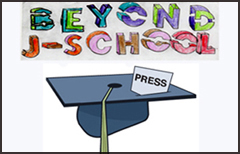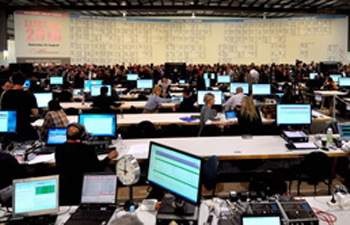Education content on MediaShift is sponsored by Carnegie-Knight News21, an alliance of 12 journalism schools in which top students tell complex stories in inventive ways. See tips for spurring innovation and digital learning at Learn.News21.com.
As Australian democracy hangs in the balance, and with the outcome of the August 21 national election unlikely to be resolved for weeks, I’m considering the implications for journalism education — and how we can invent new models for political reporting.
I am a former Australian Broadcasting Corporation political journalist who now teaches journalism in at the University of Canberra, which is situated just down the road from Australia’s national parliament. Parliament House is home to the Canberra Press Gallery, the Holy Grail of Australian political journalism.

I made a small but successful attempt at innovating political reporting in the classroom through the employment of Twitter as a student-reporting platform in a Canberra regional election in 2008. But it’s time my school, which bills itself as Australia’s “Capital University,” embarked on a political journalism project that marries journalism students and media-active citizenry with industry partners, new media players and civic agencies.
Such an approach could enable the implementation of a citizen-informed editorial agenda; the engagement of a now essential social media strategy; and the enhancement of industry partner’s political coverage, with the social objective of enabling participatory democracy. It should also provide an opportunity for academic research, so that the outcomes can be appropriately measured and academically published, as well as being reported for mass consumption through a variety of media.
Superficial Coverage
Problematic Australian political reporting, which became a theme of its own during the heavily stage-managed campaign, has been cited as one of the causes of this historic result: The first hung Parliament since World War II, and the upending of Australia’s entrenched, highly combative, two-party democracy.
Journalists have been accused of producing superficial stories that were heavily influenced by polls and the major parties’ political agendas, but light on critique and context. Citizen journalists bit back on blogs and Twitter, telling journalists to lift their game.
They complained about Press Gallery obsessions with predictions, personalities and political processes at the expense of policies. They also cited the impact of spin and campaign stage management on editorial agendas at the expense of independent, inquiring journalism as evidence of the need for changing practice. They asked why Australia’s increasingly costly involvement in the war in Afghanistan wasn’t probed during the campaign, and they wanted to know why both major parties virtually ignored climate change. This public critique of professional political journalism provoked defensive reactions from some reporters and triggered a vigorous Twitter debate on political journalism between the Fourth Estate and the New Estate. Witness the below exchange between a journalist and one of my colleagues at the university:
Four independent Members of Parliament, bent on upending the Oz political landscape, are likely to hold the Balance of Power in the new government — and they’ve already taken aim at the Fourth Estate for its failures and apparent determination to maintain the status quo. In a National Press Club (NPC) address last week, one MP, Tony Windsor, challenged the journalists present, saying, “if you people are sick of the nonsense, then promote some of [our] concepts.” Another, Rob Oakeshott, pointed to what he sees as the essence of the problem. “In focusing so heavily on the [Prime Minister], the cabinet and the polls … we have lost the focus on the local member,” he told the NPC. And with it, the local community.
A challenge
NYU journalism professor Jay Rosen visited Australia in the middle of the election campaign to speak at a national conference of journalists. He was intrigued to find what he calls horse race journalism being practiced on the Australian election campaign trail. He revived his alternative model for political reporting driven by the “citizens agenda” during his highly publicized visit. He also proposed a new role of media outlet as “explainer” for the national public broadcaster, ABC.
U.S. political journalist John Nichols was another keynote speaker at the conference. His rousing speech invoked Finley Peter Dunne (“afflict the comfortable and comfort the afflicted”) and pointed to the risk that spin increasingly amplifies the voices of the powerful and threatens journalists’ capacity to speak truth to power. It made me feel like I’d attended a revival meeting at the Church of Journalism.
Rosen’s practical challenge and Nichols’ call to faith focused my mind on the role that journalism education might play in reforming political reporting in Australia. Key targets for an overhaul of political journalism in the Australian setting are:
- The missing “citizens agenda” and active engagement with citizen journalists.
- The absence of explanatory reporting and a preference for inflammatory tabloid-style political reporting.
- The resort to the defense of objectivity in the face of political deceit.
- The concentration of political reporting on the national capital and the parliament, and the insistence on focusing campaign coverage on the traveling shows staged by the leaders of the two main political parties, Labor and the Liberal National Coalition.
Barrukka Project
There has been only limited innovation in the sphere of community and industry-partnered journalism school projects around political journalism in Australia. The best of these was YouDecide2007 project, which sought to explore the role of social media and citizen journalism in partnership with the secondary Australian public broadcaster, the multilingual SBS. This early and very successful research-driven project did not, however, systematically involve journalism students, nor did it directly feed back into journalism training. In fact, most Australian journalism schools don’t teach political journalism as a genre, and the training that does occur tends to simply model entrenched industry patterns.
Here’s what I propose: A multi-partnered, citizen-activated journalism project based at the University of Canberra in the lead up to the next national election (which could happen swiftly unless a stable government can be established in the current cliff-hanger of a ballot!). The objective would be to take the focus off the agendas of the major parties and the Canberra Press Gallery and look beyond the walls of Parliament House to the experiences and views of the broader Canberra public.
Let’s call this proposed project Barrukka, which means “talk” in an Aboriginal dialect. This name is in deference to the historically disenfranchised Indigenous Australians and it is a way of reflecting an underlying objective of connecting disempowered voices with the mainstream media and broader public.
Its four-fold purpose would be to:
- Produce citizen agenda-enhanced journalism in multiple forms, across multiple platforms (including social media like Twitter and Facebook) and aggregated on a UC-managed website.
- Produce political reporters equipped to challenge dominant media/political paradigms and produce creative content.
- Provide opportunities for citizen journalism and community engagement.
- Enhance mainstream media coverage of the election.
Senior student journalists, with the appropriate training and experience, would be embedded within the wider region’s individual electorates (which range from inner city through farmland) for one week, researching and reporting the main issues identified by community organizations, local media and candidates. Thereafter, those electorates would become their election beats and their new contacts their main sources for coverage.
The student journalists would also be tasked to recruit local leaders for community-based discussion groups. These groups would identify and explore key issues of concern and then feed those ideas into editorial processes, while group leaders would also upload content (audio, video, images, etc.) directly to the main website and via interconnected social media platforms.
Partnerships With Industry, New Media & Government
Partnerships would provide funding and support for the project. For example, UC’s journalism program could partner with the country’s respected and community-engaged, multiple-platform public broadcaster, the ABC.
A second potential partnership could be formed between UC and one of the emerging activist media groups invested in social change like Get-Up, which successfully extended voting enrollment rights during the 2010 poll through legal challenges.
A third partnership could be pursued between UC’s journalism program and the Australian Electoral Commission, the statutory body which oversees the election process and the registration of voters. One of the roles of the project would be to educate Australians about electoral processes, promote democratic engagement and stimulate voter registration.
Embedded Hyper-Local Reporting
Embedding student journalists within individual electorates and requiring them to build relationships with both the candidates and the communities, through a combination of online and traditional reporting strategies, would encourage coverage of issues which may challenge both the major parties’ strategic objectives and the Press Gallery’s narrow editorial agenda.
The student reporters would be forbidden from covering press-release generated “news” in the interests of countering spin, and they would be required to include two face-to-face interviews from non-official sources in every story filed. Their brief would be to report in an explanatory, rather than inflammatory, manner.
They would be required to file content across a range of platforms including the project website, UC journalism school radio and TV programs, Twitter, blogs and Facebook pages associated with the project. In addition, they would be expected to tweet and blog about the processes of reporting in the interests of reflexive practice. And they would be tasked to produce one podcast during the campaign about the key issues and policies concerning the assigned electorate for showcasing on the ABC’s website.
Community Forums
The embedded student journalists would identify leaders for citizen-based deliberative forums to be held in each electorate, every week of the campaign. These forum leaders would be trained in basic technical and professional skills by the project. They would be tasked to collect and file content to the project website with group members commenting on key themes emerging from each forum. They would operate like self-reporting focus groups.
They would also be asked to identify one question they would like to put to each candidate in their electorate during community Q&A forums to be staged in the final week of the campaign.
These Q&A forums would be webcast and accommodate questions from the wider audience via Twitter. They would be moderated and reported on by the student journalists involved in the project, with the possibility of content also being fed to ABC.
Research Processes/Outcomes
UC journalism academics, working with student research assistants from media studies and communication theory courses, would analyze the processes, outputs and impacts of the exercise and compare the coverage to the mainstream media’s reporting of each electorate assigned. The results of this multi-faceted academic research (incorporating quantitative and qualitative methodologies) would then be published academically and in a range of popular, accessible media with a view to feeding outcomes back into the curriculum and future projects.
At this stage, Barrukka is just a simple on-paper-only attempt at enlivening and improving political journalism education in Australia. But I am about to return to the classroom after a long stint of maternity leave, with fresh eyes and renewed purpose — and I will do my best to turn this idea into a reality. Meantime, watch on as Australian democracy undergoes renovation. You may be inspired too.
If you are interested in being involved as a partner or a sponsor in this proposed project, please email me.
Julie Posetti is an award winning journalist and journalism academic who lectures in radio and television reporting at the University of Canberra, Australia. She’s been a national political correspondent, a regional news editor, a TV documentary reporter and presenter on radio and television with the Australian national broadcaster, the ABC. Her academic research centers on talk radio, public broadcasting, political reporting and broadcast coverage of Muslims post-9/11. She blogs at J-Scribe and you can follow her on Twitter.
Education content on MediaShift is sponsored by Carnegie-Knight News21, an alliance of 12 journalism schools in which top students tell complex stories in inventive ways. See tips for spurring innovation and digital learning at Learn.News21.com.

